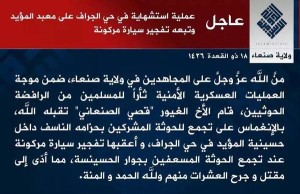The Islamic State’s so-called “province” in Sanaa, Yemen has claimed responsibility for two bombings at a mosque earlier today. According to initial casualty reports, at least 20 people were killed. A suicide bomber struck inside the mosque, followed by a car bombing outside of it. The second bomb was evidently intended to take out the medical personnel and others who rushed to the scene. This is a standard jihadist tactic to maximize casualties.
The Islamic State portrays this as a justifiable strike against the Shiite Houthis. But the Associated Press reports that the mosque is “frequented by both Sunni and Shiite Muslims.”
The attack highlights, once again, a key difference between the Islamic State and al Qaeda’s rules of engagement. Whereas Abu Bakr al Baghdadi’s fighters do not hesitate to hurl themselves at mosques and other places filled with Houthi civilians, Ayman al Zawahiri’s general guidelines for waging jihad prohibit the deliberate targeting of Shiite and Houthi civilians. Al Qaeda’s jihadists have been ordered to focus primarily on hard targets, like security and military personnel.
This difference in tactics was on display in March, when the Islamic State’s “province” claimed responsibility for its first major operations inside Yemen. After the “caliphate’s” suicide bombers launched coordinated assaults on two mosques, al Qaeda in the Arabian Peninsula (AQAP) quickly issued a statement distancing itself from the massacres. AQAP stressed that it remains “committed to the guidelines” issued by Sheikh Ayman al Zawahiri. [See LWJ report, Analysis: Why AQAP quickly denied any connection to mosque attacks.]
Are you a dedicated reader of FDD's Long War Journal? Has our research benefitted you or your team over the years? Support our independent reporting and analysis today by considering a one-time or monthly donation. Thanks for reading! You can make a tax-deductible donation here.








